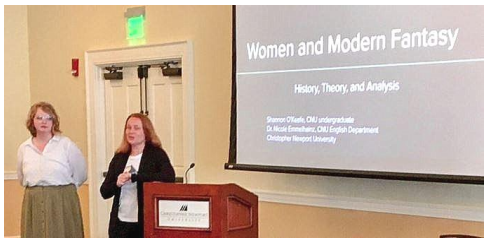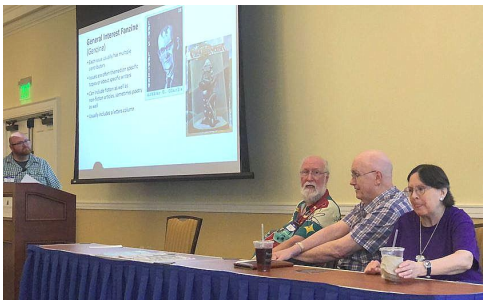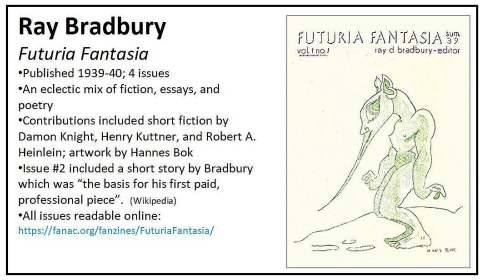(1) THUMB OUT, THUMBS DOWN. The 1979 Best Dramatic Hugo race is analyzed by the Hugo Book Club Blog in “Death From Above (Hugo cinema 1979)”. In spite of everything going for it, this finalist did not win:
…Hitchhiker’s Guide To the Galaxy is rightly regarded as a classic of science fiction comedy. Those in our cinema club who love it, do so unreservedly … but it was not to everyone’s taste. Understated and ironic, some consider it a masterpiece of timing and laconic charm, despite the dialogue feeling loose and unstructured. Following an everyday Englishman who survives the destruction of planet Earth, the series meanders between various science fiction tropes before the protagonist uncovers the galactic conspiracy behind his planet’s demolition. There’s a reason this radio show spawned four sequels, was adapted into a television series, a movie, a video game, and a novelization that sold more than 14 million copies….
(2) URSULA VERNON’S GOOD NEWS.
(3) SMALL WONDERS. Issue 7 of Small Wonders, the magazine for science fiction and fantasy flash fiction and poetry, is now available on virtual newsstands here. Co-editors Cislyn Smith and Stephen Granade bring a mix of flash fiction and poetry from authors and poets who are familiar to SFF readers as well as those publishing their first-ever piece with us.
The Issue 7 Table of Contents and release dates on the Small Wonders website:
- Cover Art: “Entrance” by Sarah Morrison
- “Hikari” (fiction) by Morgan Welch (8 Jan)
- “The Mummy Gets Adopted” (poem) by Amy Johnson (10 Jan)
- “Quantum Eurydice” (fiction) by Avi Burton (12 Jan)
- “Whispers of Ascension” (fiction) by Wendy Nikel (15 Jan)
- “Lekythos” (poem) by Casey Lucas (17 Jan)
- “The Sternum Ties it All Together” (fiction) by Janna Miller (19 Jan)
- “Constellations of Flesh, Bone, and Memory” (fiction) by Timothy Hickson (22 Jan)
- “Another Cemetery Wedding ” (poem) by Belicia Rhea (24 Jan)
- “All the Dead Girls, Singing” (fiction) by Avra Margariti (26 Jan)
Subscriptions are available at the magazine’s store and on Patreon.

(4) MEDICAL UPDATE. Rusty Burke experienced a serious fall on December 16, resulting in severe head injuries and two subdural hematomas. Since then, he has been under intensive care, including intubation and sedation. There’s an extensive medical update at “The World of Robert E. Howard” on Facebook.
Rusty Burke is President of the Robert E. Howard Foundation, has edited several editions of Howard’s work, and has published countless articles on Howard for the academic and fan press. He founded The Dark Man: Journal of Robert E. Howard and Pulp Studies.
(5) EATING THE FANTASTIC. Scott Edelman invites listens to join Pat Murphy for lunch at “the single best restaurant in the world” in Episode 215 of the Eating the Fantastic podcast.

My guest this time around is Pat Murphy, who won the Nebula Award for her 1986 novel The Falling Woman, plus a second Nebula the same year for her novelette, “Rachel in Love.” She also won the Philip K. Dick Award for her 1990 short story collection Points of Departure, and the World Fantasy Award for her 1990 novella, Bones. For more than 20 years, she and Paul Doherty cowrote the recurring Science column in the Magazine of Fantasy & Science Fiction. She also co-founded the James Tiptree, Jr. Award in 1991. And that’s just the tip of the iceberg.
I’ve known Pat for a loooong time, and I can tell you exactly how long — we met on September 4, 1980, more than 43 years prior to the conversation you’re about to hear. If you want to learn exactly how and why I can pinpoint that date, well, the episode will reveal all.
We discussed the part of Robert A. Heinlein’s famed rules of writing with which she disagrees, why she felt the need to attend the Clarion writing workshop even after having made several sales to major pro markets, the occasional difficulties in decoding what an editor is truly trying to tell you, the importance of never giving up your day jobs, why she can’t read Dylan Thomas when she’s working on a novel, the differences between the infighting we’ve seen in the science fiction vs. literary fields, what we perceive as our personal writing flaws, a Clarion critiquing mystery I’ve been attempting to solve since 1979, the science fiction connection which launched her career at the Exploratorium, and much more.
(6) ATWOOD. Margaret Atwood has been revealing aspects of her life and writing to BBC Radio 4’s This Cultural Life. Download program at the link.
Margaret Atwood talks to John Wilson about the formative influences and experiences that shaped her writing. One of the world’s bestselling and critically acclaimed authors, Atwood has published over 60 books including novels, short stories, children’s fiction, non-fiction and poetry. She’s known for stories of human struggle against oppression and brutality, most famously her 1985 novel The Handmaid’s Tale, a dystopian vision of America in which women are enslaved. She has twice won the Booker Prize For Fiction, in 2000 for The Blind Assassin and again in 2019 for her sequel to The Handmaid’s Tale, The Testaments.
Growing up in remote Canadian woodland with her scientist parents, she traces her career as a story-teller back to sagas that she invented with her older brother as a child, and her first ‘novel’ written when she was seven. She recalls an opera about fabrics that she wrote and performed at high school for a home economics project, and how she staged puppet shows for children’s parties. Margaret Atwood also discusses the huge impact that reading George Orwell had on her, and how his novel Nineteen Eighty-Four especially influenced The Handmaid’s Tale. She reveals how that novel – written whilst she was living in Berlin in 1985 – was initially conceived after the 1980 election of President Ronald Reagan and the resurgence of evangelical right-wing politics in America.

(7) ECSTASY OF HORROR. The BBC ruminates on “The Wicker Man: The disturbing cult British classic that can’t be defined”.
…At different times and from different perspectives, it can feel as though you’re watching a crime thriller, a fantasy, a celebration of alternate lifestyles or nature-centred folklore – or brilliantly conceived arthouse cinema. In the 2008 book Fifty Key British Films, Justin Smith considered The Wicker Man “a curious mixture of detective story and folk musical”.
The Wicker Man can also be watched as a challenge to orthodox religion – not least when Lord Summerisle defends his pagan ethos by wryly questioning Howie’s Christian worship of “the son of a virgin impregnated by a ghost”. Or perhaps it’s the first mockumentary in British cinema history, given an opening credit offering thanks to Summerisle residents “for this privileged insight into their religious practices and for their generous cooperation in the making of this film”….
(8) AT SWIM-TWO-BIRDS AND GRAHAM GREENE. [Item by James Bacon.] Irish science fiction fan Pádraig Ó Méalóid investigates the circumstances under which one of the leading novelists of the twentieth century, Graham Greene, came to write a blurb for the back cover of the first edition of Flann O’Brien’s debut novel At Swim-Two-Birds, published by Longmans, Green & Co. in 1939. “The Mexican Pas de Trois of Flann O’Brien, Graham Greene, and Shirley Temple: The Background to At Swim-Two-Birds’s Back Cover Blurb” at The Parish Review: Journal of Flann O’Brien Studies.
…Greene had worked as a publisher’s reader for Eyre & Spottiswoode in his younger days,13 but by the time At Swim-Two-Birds was published in 1939 he had already had eight novels published, including England Made Me (1935) and Brighton Rock (1938), so was probably both too busy and too successful to be working for anyone as a first reader for incoming manuscripts from first-time writers. At Swim-Two-Birds came to Longmans recommended by A.M. Heath, which might have meant that it would have started its journey on a higher rung than a book straight off the slush pile…
(9) ROGER HILL (1948-2023). “Roger Hill, Early Comics Fan, Historian and Scholar, Dies at 75” — The Comics Journal paid tribute. Here’s a brief excerpt:
… During the early 1990s, Roger worked with [Jerry] Weist as comic art advisor to the Sotheby’s Comic Book and Comic Art auctions in New York City.
Beginning in 2004, he edited and published his own fanzine called the EC Fan-Addict Fanzine. The fifth issue was published by Fantagraphics in November 2023, and a sixth, posthumous issue is due out in June 2024 (also from Fantagraphics). He was the art editor for Bhob Stewart’s 2003 book Against the Grain: MAD Artist Wallace Wood, writing several chapters as well. In 2010, Roger contributed an essay called “The Early Years” for the Éditions Déesse edition of the WOODWORK: Wallace Wood 1927-1981 catalog done for the Wally Wood exhibition presented by the Casal Solleric in Palma City, Spain. After Jerry Weist’s passing, in 2012 Roger and Glynn Crain finished assembling his book Frank R. Paul: The Dean of Science Fiction Illustration for IDW Publishing.
Roger’s first book, Wally Wood: Galaxy Art and Beyond, was published by IDW in 2016. His other books include Reed Crandall: Illustrator of the Comics (2017), Mac Raboy: Master of the Comics (2019), and The Chillingly Weird Art of Matt Fox (2023), all for TwoMorrows Publishing….
(10) TOM WILKINSON (1948-2023). [Item by Cat Eldridge.] Definitely one of ours — Shakespeare in Love as Hugh Fennyman, the fantasy film Black Knight in the role of Sir Knolte of Marlborough, in the sublime Eternal Sunshine of the Spotless Mind as as Dr. Howard Mierzwiak, next is Batman Begins as Mafia boss Carmine Falcone, The Exorcism of Emily Rose has him playing Father Moore, he’s a taxi driver in the romantic fantasy If Only and finally he’s James Reid in The Green Hornet.
Late in his career, he had two animated genre voicing credits. First as The Fox in The Gruffalo’s Child based off the picture book of the same name written by Julia Donaldson and illustrated by Axel Scheffler. It looks adorable.
The second is yet another of the seemingly endless credits for Watership Down, this time for the character Threarah.
Died December 30.
(11) TODAY’S BIRTHDAY.
[Written by Cat Eldridge.]
Born December 30, 1865 — Rudyard Kipling. (Died 1936.) Yes, Rudyard Kipling. I’ve not ever dealt with him at length so let’s do so now.
I think the works I like best by him are The Jungle Book and The Second Jungle Book, the 1894 and 1895 collections of stories. Most of the characters are animals such as Shere Khan the tiger and Baloo the bear, though a main character is a boy Mowgli. As with most of his work, it reflects strongly his Anglo-Indian heritage and upbringing.

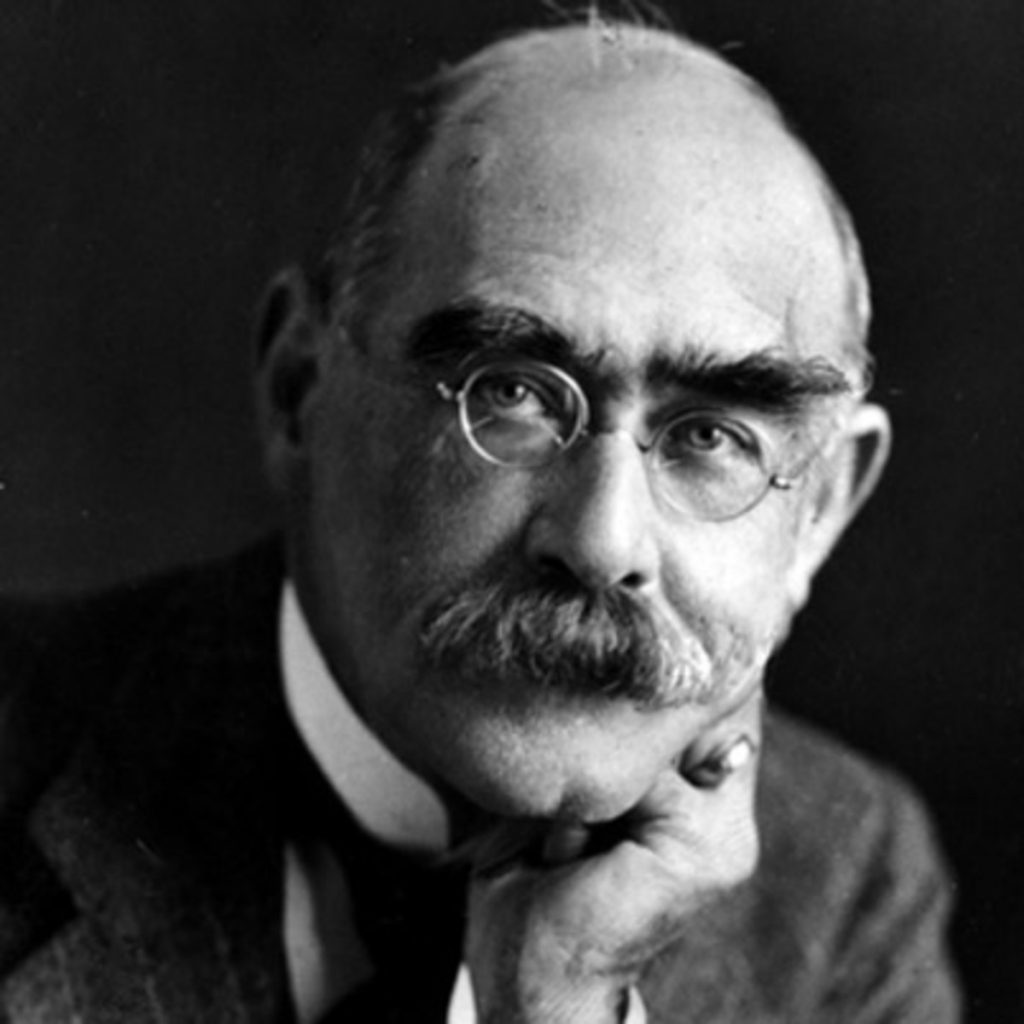
Up next for us is the Just So Stories for Little Children written eight years later. This collection of origin stories such as how the elephant got his trunk is considered a classic of children’s literature, and deservedly so.
Puck of Pook’s Hill borrows that character, and you know which character I mean, and drops him in 1906 Britain for a series of comical adventures with two children. Really, really fun stories.
He’s written at least two ghost stories, “The Phantom ‘Rickshaw” and “My Own True Ghost Story” published in his 1888 The Phantom ‘Rickshaw & other Eerie Tales collection.
Lastly he did write some SF. To wit, “With the Night Mail” a 1905 story and As Easy As A.B.C., a 1912 publication. (Both were set in the 21st century in Kipling’s Aerial Board of Control universe.) The first was published in McClure’s Magazine in November 1905, and then in The Windsor Magazine in December 1905. In 1909 it was issued as a popular book, slightly revised and with additional poetry and faux advertisements and notices from the future. Both have anthologized repeatedly in the last one hundred and twenty-five years.
(12) COMICS SECTION.
- Bizarro has that name for good reason, as this arrest for a peculiar game-related crime will show.
- Nancy sounds like someone who went to the same school as Writer X.
- Tom Gauld presents:
(13) SPARKLING DEBUT. This is who was named TVLine’s “Performer of the Week”: “Ncuti Gatwa’s Performance as the Fifteenth in ‘Doctor Who’ Special”.
…On top of it all, Gatwa also plays the more serious moments so well, mining them not just for the inherent drama (Ruby has mysteriously vanished from the timeline!) but also the emotion. Watch him watch the woman who left newborn Ruby at the church doorstep walk away, and you feel the conflict. The heartbreak. Perhaps a hint of recognition…? And then, Fifteen’s eventual resolve to stick to his plan.
Gatwa has stepped into this role with such elan and ease, while also infusing it with specific and fresh nuances, well, it’s almost as if he’s been playing it for 900 years.
(14) TOMB OF THE UNKNOWN ALIEN. Atlas Obscura takes readers to “1890s Alien Gravesite – Aurora, Texas”.
According to a story run in the April 19, 1897, edition of the Dallas Morning News a “mystery airship,” as UFOs were known in those days, came sailing out of the sky, smashing through a windmill belonging to Judge J.S. Proctor, before finally crashing into the ground. The debris also destroyed the good judge’s flower garden. Unfortunately the pilot was also killed in the collision, but locals were able to drag what was described as a “petite” and “Martian” body from the wreckage. The body was supposedly buried under a tree branch in the Aurora cemetery, observing good Christian rites….
…Today, the alien’s headstone has been stolen but all traces of the Wild West alien spot are not lost. The Texas state historical marker that commemorates the cemetery still mentions the Martian burial among the other honored (and real) dead buried at the site….
(15) HE’S GOT TO HAVE IT. “’I’d sell a kidney for a Jarvis Cocker Spitting Image puppet!’ The collectors who’ll do anything for a TV treasure” in the Guardian.
…Is there any piece of television treasure [TV writer Tom Neenan is] still holding out for? “There is a Spitting Image puppet of Jarvis Cocker from the 90s that’s really spindly and awesome. If that came up I’d consider selling a kidney or something to buy it,” says Neenan. “Oh and I’m building a Dalek at the minute. It’s based on the plans for the new series and it’s all built by me but I’m very jealous of people who have a screen-used Dalek.”
Ah yes, Daleks. Holy mackerel, there is a wealth of Doctor Who collectors, hunters and enthusiasts out there, meeting up in conference centres, museums and online message boards to compare their wares. It is on one such website that I first came across Chris Balcombe, a man who owned and restored an original 1960s Dalek….
(16) FRIGHTENINGLY NUTRITIOUS. This 1945 Cream of Wheat ad was illustrated by Charles Addams. (Click for larger image.)
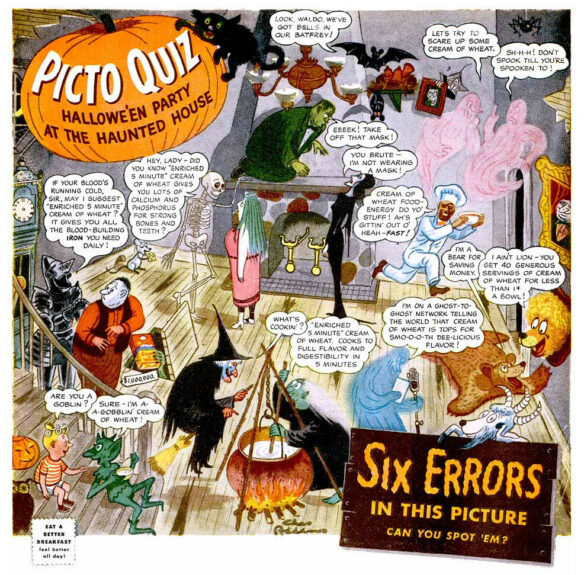
[Thanks to Cat Eldridge, SF Concatenation’s Jonathan Cowie, Steven French, Olav Rokne, Rich Horton, Scott Edelman, James Bacon, Mike Kennedy, Andrew Porter, John King Tarpinian, and Chris Barkley for some of these stories. Title credit belongs to File 770 contributing editor of the day Tom Becker.]


